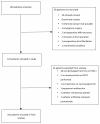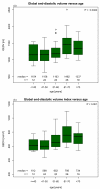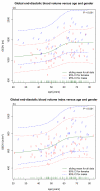Global end-diastolic volume acquired by transpulmonary thermodilution depends on age and gender in awake and spontaneously breathing patients
- PMID: 20003415
- PMCID: PMC2811898
- DOI: 10.1186/cc8209
Global end-diastolic volume acquired by transpulmonary thermodilution depends on age and gender in awake and spontaneously breathing patients
Abstract
Introduction: Volumetric parameters acquired by transpulmonary thermodilution had been repeatedly proven superior to filling pressures for estimation of cardiac preload. Up to now, the proposed normal ranges were never studied in detail. We investigated the relationship of the global end-diastolic volume (GEDV) acquired by transpulmonary thermodilution with age and gender in awake and spontaneously breathing patients.
Methods: Patients requiring brain tumor surgery were equipped prospectively with a transpulmonary thermodilution device. On postoperative day one, thermodilution measurements were performed in 101 patients ready for discharge from the ICU. All subjects were awake, spontaneously breathing, hemodynamically stable and free of catecholamines.
Results: Main finding was a dependence of GEDV on age and gender, height and weight of the patient. Age was a highly significant non-linear coefficient for GEDV with large inter-individual variance (p < 0.001). On average, GEDV was 131.1 ml higher in males (p = 0.027). Each cm body height accounted for 13.0 ml additional GEDV (p < 0.001). GEDV increased by 2.90 ml per kg actual body weight (p = 0.043). Each cofactor, including height and weight, remained significant after indexing GEDV to body surface area using predicted body weight.
Conclusions: The volumetric parameter GEDV shows a large inter-individual variance and is dependent on age and gender. These dependencies persist after indexing GEDV to body surface area calculated with predicted body weight. Targeting resuscitation using fixed ranges of preload volumes acquired by transpulmonary thermodilution without concern to an individual patient's age and gender seems not to be appropriate.
Figures




References
MeSH terms
LinkOut - more resources
Full Text Sources
Medical

